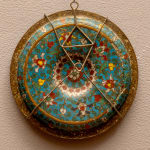Unknown
A rare and very elegant Chinese mid sixteenth century Ming Dynasty cloisonné enamel dish, featuring a central circular medallion encircling red Chinese characters on a white ground surrounded by a ring of stylised green leaves outlined in gold, set within a white ground with gold spiral cloisons resembling fish-scales, within a ring of red flower heads on a green ground and outer ring of gold spiral cloisons resembling a rice-grain pattern on a white ground. The reverse of the dish decorated with a red, white and yellow flower head amid a dark turquoise ground decorated with openwork gold spiral cloisons, the outer edge with more symmetrical gold spirals on a white ground
China, date circa 1550
Diameter 16.5 cm.
Literature: Claudia Brown, “Chinese Cloisonne, The Clague Collection”, 1980, pp. 32-38, pls. 8-11, illustrating four mid sixteenth century Ming cloisonné enamel bowls from the Clague collection, which feature as here a dominant decoration of spiral cloisons, place in even rows on a white or coloured ground to resemble a ‘rice-grain’ pattern.
In her cataloguing of the Robert and Marian Clague collection of Chinese cloisonné, Claudia Brown describes four Ming bowls, where the decoration is dominated by large borders of repeated spiralled cloisons in a single colour that resemble a rice-grain pattern, of which the most apparent and closest to our piece is the interior of a bowl (pl. 8, described and illustrated pp. 32-3), which is profusely decorated in the interior with concentric rows of spiral cloisons. All have loose spiral wires used as background fillers or as independent motifs, they are also of thin construction, have a distinctive matte surface and a propensity toward white enamels. She dates them to the mid sixteenth century and concludes that they probably come from a single workshop. It is possible that the present dish may have come from a similar or even the same workshop.
Foreign influence contributed to the development of the art of Chinese cloisonné enamel during the early fourteenth to fifteenth century. The earliest securely dated Chinese cloisonné is from the reign of the Ming Xuande emperor (1426–35). However, cloisonné is recorded during the previous Yuan Dynasty, and it has been suggested that the technique was introduced to China at that time via the western province of Yunnan, which, under Mongol rule, received an influx of Islamic people. A very few cloisonné objects have been dated on stylistic grounds to the Yongle reign (1403–24) of the early Ming dynasty but it was not however until slightly later during the dynasty that the art of cloisonné enamel became highly developed and widely popular among the Chinese Imperial court and the elite.
Cloisonné is a technique of creating designs on metal vessels with coloured-glass paste placed within enclosures made of copper or bronze wires, which have been bent or hammered into the desired pattern. Known as cloisons (French for ‘partitions’), the enclosures generally are either pasted or soldered onto the metal body. The glass paste, or enamel, is coloured with metallic oxide and painted into the contained areas of the design. The vessel is usually fired at a relatively low temperature, about 800°C. Enamels commonly shrink after firing, and the process is repeated several times to fill in the designs. Once this process is complete, the surface of the vessel is rubbed until the edges of the cloisons are visible. They are then gilded, often on the edges, in the interior, and on the base.
Cloisonné objects were intended primarily for the furnishing of temples and palaces, because their flamboyant splendour was considered appropriate to the function of these structures and not well suited to a more restrained atmosphere, such as that of a scholar’s home. This opinion was expressed by Cao Zhao in 1388 in his influential Gegu Yaolun (Guide to the Study of Antiquities), in which cloisonné was dismissed as being suitable only for lady’s chambers. However, by the period of Emperor Xuande (1425-35), this ware came to be greatly prized at court.



